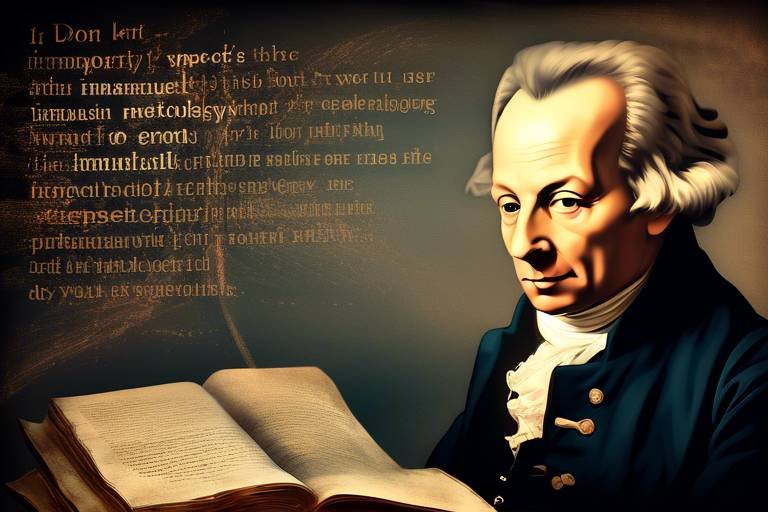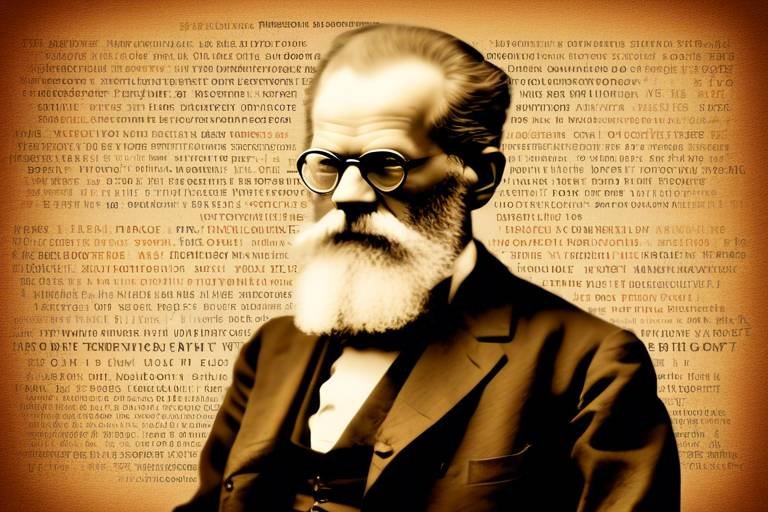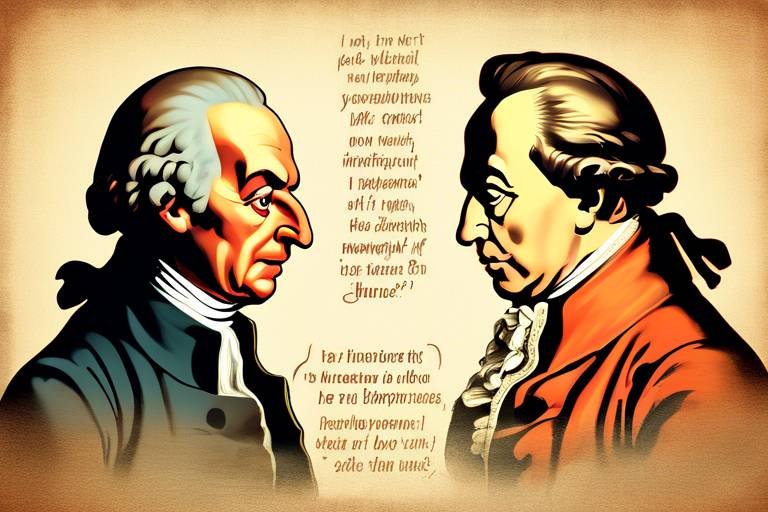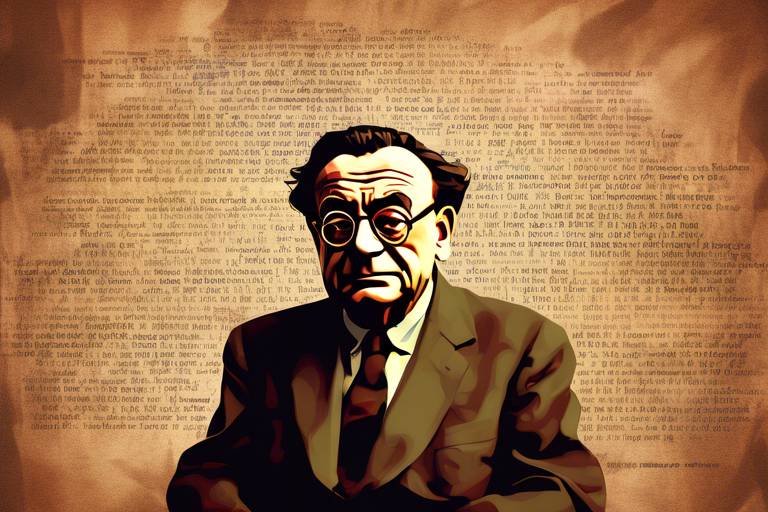Harper Lee's Philosophy in To Kill a Mockingbird
Harper Lee's novel, To Kill a Mockingbird, is not just a story set in the racially charged American South; it is a profound exploration of human morality, justice, and empathy. Through the eyes of young Scout Finch, we are invited to witness the complexities of human behavior and the societal structures that shape our beliefs. Lee's philosophical commentary resonates deeply, urging readers to reflect on their own values and the world around them. The narrative is rich with lessons that challenge us to confront our biases and embrace compassion, making it a timeless piece that continues to inspire discussions about morality and human rights.
Moral education is a central theme in To Kill a Mockingbird, showcasing how characters like Atticus Finch instill values of integrity and empathy in their children amidst societal prejudices. Atticus serves as a beacon of morality, guiding Scout and her brother Jem through the murky waters of their community’s injustices. He teaches them that true strength lies in understanding and respecting others, regardless of their background. This lesson is particularly poignant in a world where societal norms often dictate a lack of compassion. The Finch household becomes a sanctuary of ethical values, where love and guidance shape the children’s understanding of right and wrong.
Empathy plays a crucial role in the narrative, emphasizing the importance of understanding others' perspectives. This is beautifully illustrated through Scout and Boo Radley's evolving relationship throughout the story. Initially, Boo is portrayed as a mysterious figure, shrouded in rumors and fear. However, as Scout matures, she learns to see beyond her preconceived notions. The moment she stands on Boo's porch and views her neighborhood from his perspective is a powerful testament to the transformative power of empathy. It challenges readers to consider how often we judge others based on fear rather than understanding, urging us to look deeper and recognize our shared humanity.
Atticus Finch embodies the moral compass of the story, teaching his children the significance of compassion and justice in a world rife with discrimination and hatred. He stands firm in his beliefs, even when faced with overwhelming opposition from his community. His unwavering commitment to defending Tom Robinson, an innocent black man falsely accused of raping a white woman, serves as a pivotal moment in the narrative. Atticus's actions not only highlight the fight against racial injustice but also reinforce the idea that standing up for what is right is a moral obligation, regardless of the consequences. His character inspires readers to reflect on their own roles in combating injustice and advocating for those who cannot defend themselves.
Through Atticus's defense of Tom Robinson, Lee highlights the struggle against racial injustice and the moral duty to stand up for what is right, regardless of public opinion. Atticus's courtroom speeches resonate with profound truths about humanity, urging the jury to look beyond race and consider the evidence presented. His defense is not just a legal battle; it is a fight for dignity and respect for all individuals. The outcome, while tragic, serves as a stark reminder of the pervasive nature of prejudice and the importance of striving for justice, even in the face of defeat.
Atticus's parenting style serves as a model for instilling ethical values. He demonstrates how love and guidance can shape a child's understanding of morality and social responsibility. By encouraging Scout and Jem to ask questions and form their own opinions, he fosters an environment of critical thinking. Atticus's approach is not about imposing beliefs but rather guiding his children to discover their own moral compass. This method of parenting is a powerful lesson for all, reminding us that nurturing empathy and understanding in the next generation is crucial for creating a more just society.
The novel vividly portrays the consequences of social injustice, prompting readers to reflect on their own beliefs and the societal structures that perpetuate inequality and discrimination. The events that unfold in Maycomb serve as a microcosm of the larger societal issues that plague humanity. Lee's narrative compels us to confront uncomfortable truths about our own communities and the biases that may lie beneath the surface. As we witness the struggles of characters like Tom Robinson and Boo Radley, we are reminded of the importance of advocating for justice and standing in solidarity with the marginalized.
Lee explores the duality of human nature, revealing that individuals are capable of both good and evil, and challenging the reader to confront their own moral complexities. The characters in To Kill a Mockingbird are not merely heroes or villains; they are multifaceted beings shaped by their experiences and choices. This complexity invites readers to reflect on their own lives and the moral dilemmas they face, encouraging a deeper understanding of what it means to be human.
Boo Radley serves as a symbol of misunderstood kindness, illustrating how fear and prejudice can distort perceptions of others. Initially viewed as a reclusive monster, Boo ultimately reveals himself to be a protector and friend. His transformation from a figure of fear to one of compassion is a powerful reminder of the importance of looking beyond appearances. As Scout learns to see Boo for who he truly is, readers are encouraged to challenge their own biases and embrace the complexities of human nature.
The mockingbird symbolizes innocence and the moral imperative to protect the vulnerable. This metaphor reinforces the novel's overarching message about the importance of safeguarding those who cannot defend themselves. Characters like Tom Robinson and Boo Radley represent the mockingbird, embodying the idea that harming those who do no wrong is a grave injustice. Lee's poignant reminder to "never kill a mockingbird" resonates deeply, urging us to nurture and protect the innocence in our world.
- What is the main theme of To Kill a Mockingbird?
The main theme revolves around moral growth, empathy, and the fight against social injustice. - Who is the moral center of the novel?
Atticus Finch serves as the moral center, teaching his children about compassion and justice. - How does Boo Radley symbolize innocence?
Boo Radley represents misunderstood kindness and the importance of looking beyond fear and prejudice. - What does the mockingbird symbolize?
The mockingbird symbolizes innocence and the moral obligation to protect those who cannot protect themselves.

The Importance of Moral Education
This article explores the core philosophies presented in Harper Lee's renowned novel, examining themes of morality, justice, and human empathy through the lens of its characters and narrative structure.
Moral education is not just a theme in To Kill a Mockingbird; it's the very backbone of the narrative. Through the character of Atticus Finch, Harper Lee illustrates how critical it is to instill values of integrity and empathy in the younger generation, especially when surrounded by societal prejudices and injustices. Atticus, as a father, goes beyond mere instruction; he embodies the principles he wishes to impart. His approach to parenting is a blend of love, respect, and guidance, which serves as a powerful model for moral education.
In a world where children are often influenced by the biases and hatred of adults, Atticus stands out as a beacon of hope and morality. He teaches his children, Scout and Jem, not just the difference between right and wrong, but the importance of understanding the world from others' perspectives. He often reminds them, "You never really understand a person until you consider things from his point of view." This lesson is crucial in a society rife with discrimination, as it encourages empathy and compassion, traits that are often overshadowed by ignorance.
Moreover, the novel emphasizes that moral education is not confined to the classroom; it is a lifelong journey. Atticus’s lessons extend beyond verbal teachings. They are woven into the fabric of everyday life, as he navigates complex moral dilemmas, such as defending Tom Robinson, an African American man wrongfully accused of a crime. Through these experiences, Scout and Jem learn the harsh realities of their community, but they also learn the importance of standing up for what is right, even when it's unpopular. This duality of moral education—learning through both instruction and experience—helps shape their characters and beliefs.
In essence, the importance of moral education in To Kill a Mockingbird can be summarized in a few key points:
- Integrity: Atticus teaches his children to uphold their principles, even when faced with adversity.
- Empathy: He instills the value of understanding others, which is crucial in combating prejudice.
- Social Responsibility: Atticus’s actions show that moral education goes hand-in-hand with the duty to advocate for justice.
Lee’s narrative challenges readers to reflect on their own moral education. Are we teaching the next generation the values they need to navigate a complex world? The lessons imparted by Atticus Finch resonate far beyond the pages of the book, urging us to cultivate a society where empathy and integrity thrive. As we ponder these themes, we are left with the question: how can we, like Atticus, be better educators of morality in our own lives?
- What is the main message about moral education in the novel? The novel emphasizes the importance of teaching empathy, integrity, and social responsibility, particularly through the character of Atticus Finch.
- How does Atticus Finch embody moral education? Atticus serves as a moral compass for his children, demonstrating through his actions and teachings the significance of standing up for justice and understanding others.
- Why is empathy important in To Kill a Mockingbird? Empathy allows characters like Scout and Jem to see the world from different perspectives, which is essential in combating societal prejudices and fostering understanding.
- Can the lessons from the book be applied today? Absolutely! The themes of moral education, empathy, and social justice are as relevant today as they were during the time the novel is set.

Empathy as a Guiding Principle
In Harper Lee's To Kill a Mockingbird, empathy is not just a theme; it is the very essence that breathes life into the narrative. The story invites readers to step into the shoes of others, to see the world through different eyes. This is particularly evident in the relationship between Scout Finch and Boo Radley. Initially, Boo is shrouded in mystery and fear, a figure of local legend who embodies the unknown. However, as the story unfolds, Scout learns to view Boo not as a monster, but as a person deserving of understanding and compassion. This transformation is a beautiful illustration of how empathy can dismantle prejudice and fear.
One of the pivotal moments that highlight this principle occurs when Scout finally meets Boo. She stands on his porch and reflects on her past misconceptions, realizing that her initial judgments were rooted in ignorance. This moment serves as a powerful reminder that our perceptions can be skewed by societal narratives and that true understanding comes from personal experience. Lee masterfully shows that when we open ourselves to empathy, we not only enrich our own lives but also foster connections that can bridge the gaps between us.
Moreover, the character of Atticus Finch serves as a beacon of empathy throughout the novel. He teaches his children that understanding others is crucial, especially when faced with injustice. Atticus's famous advice to Scout, "You never really understand a person until you consider things from his point of view," encapsulates this philosophy. It is a lesson that resonates deeply in a world where division often overshadows compassion. By modeling empathetic behavior, Atticus instills in his children the importance of seeing beyond their own experiences and recognizing the humanity in others.
Empathy is not merely a passive feeling; it is an active choice that requires effort and intention. In the novel, we see how the characters who embody empathy—like Atticus and Scout—are often faced with challenges that test their beliefs. Yet, they persist in their commitment to understanding and kindness. This resilience in the face of adversity is what makes their journey so compelling and relatable. It encourages readers to reflect on their own lives and consider how they can practice empathy in their daily interactions.
In a broader sense, Lee's exploration of empathy serves as a critique of societal norms that encourage division and hatred. The prejudices that permeate the community of Maycomb are starkly contrasted with the empathetic actions of Atticus and his children. This juxtaposition challenges readers to confront their own biases and consider how they can contribute to a more empathetic society. The novel ultimately posits that empathy is not just a moral choice; it is a necessary foundation for justice and social harmony.
As we delve deeper into the narrative, we see that empathy is not limited to the main characters. Even secondary characters, such as Calpurnia, the Finch family's housekeeper, demonstrate profound understanding and compassion. Calpurnia bridges the gap between the white and black communities, showing that empathy can transcend societal barriers. Her role reminds us that everyone has a story worth hearing, and that understanding those stories is crucial for fostering a more inclusive world.
In conclusion, empathy stands as a guiding principle in To Kill a Mockingbird, urging readers to embrace the complexity of human relationships. By challenging us to look beyond our own experiences and to seek understanding in the lives of others, Lee crafts a narrative that is as relevant today as it was when it was first published. The lessons of empathy resonate deeply, reminding us that in a world often clouded by division, it is our ability to connect with one another that ultimately defines our humanity.
- What is the main theme of empathy in To Kill a Mockingbird?
Empathy is a central theme that encourages understanding and compassion towards others, particularly in the context of societal prejudices. - How does Atticus Finch teach empathy?
Atticus teaches empathy by modeling understanding and compassion, urging his children to consider things from others' perspectives. - What role does Boo Radley play in illustrating empathy?
Boo Radley represents misunderstood kindness, showing how fear can distort perceptions and how understanding can lead to personal growth.

The Role of Atticus Finch
Atticus Finch is not just a character in Harper Lee's masterpiece; he is the moral backbone of To Kill a Mockingbird. As a lawyer and a father, Atticus embodies the principles of justice, integrity, and compassion, which are vital in a society steeped in prejudice and discrimination. He stands as a beacon of hope, demonstrating that one person can make a difference in the fight for what is right. His unwavering commitment to justice is not merely a professional obligation, but a personal mission that shapes his interactions with his children, Scout and Jem, as well as the community around him.
Through Atticus's eyes, readers are introduced to the harsh realities of racism and social injustice. He teaches his children that true courage is not the absence of fear, but the determination to do what is right, even when the odds are stacked against you. This is particularly evident in his defense of Tom Robinson, a black man wrongfully accused of raping a white woman. Atticus's decision to take on this case, despite knowing the backlash he would face, illustrates his deep-seated belief in equality and justice.
Atticus's parenting style is equally significant. He doesn't just dictate rules; instead, he engages in conversations with Scout and Jem, encouraging them to think critically about their actions and the world around them. He often uses real-life examples to teach lessons, making moral education a part of their everyday life. For instance, when Scout struggles with her schoolmates’ prejudices, Atticus gently guides her to understand their behavior through the lens of empathy and compassion. This approach not only nurtures their moral development but also fosters a sense of responsibility toward others in society.
In many ways, Atticus serves as a role model not just for his children, but for readers as well. He challenges us to reflect on our own values and the importance of standing up against injustice. His famous quote, “You never really understand a person until you consider things from his point of view,” encapsulates his philosophy and serves as a guiding principle throughout the narrative. This perspective is crucial in a world where misunderstandings and prejudice can lead to devastating consequences.
Furthermore, Atticus's character is a reminder that moral integrity often comes at a cost. He faces hostility from his neighbors and is subjected to slurs and insults for defending Tom Robinson. Yet, he remains steadfast in his beliefs, teaching his children the importance of maintaining one's principles, regardless of societal pressures. This resilience in the face of adversity is a powerful lesson for all of us, encouraging us to stand firm in our convictions and advocate for those who cannot advocate for themselves.
Ultimately, Atticus Finch is a symbol of hope, demonstrating that one person’s actions can inspire change. His legacy is not just about winning a case; it’s about instilling values of justice, empathy, and moral courage in the next generation. As we navigate our own lives, we can look to Atticus as a reminder that standing up for what is right is not just a choice; it is a responsibility.
- Who is Atticus Finch? Atticus Finch is the protagonist's father in To Kill a Mockingbird, known for his strong moral principles and commitment to justice.
- What does Atticus teach his children? He teaches them the values of empathy, integrity, and the importance of standing up for what is right, even in the face of adversity.
- Why is Atticus's defense of Tom Robinson significant? It highlights the themes of racial injustice and moral duty, showcasing Atticus's commitment to equality and justice.
- How does Atticus influence the community? Through his actions and principles, Atticus challenges societal norms and encourages others to reflect on their beliefs about justice and morality.

Atticus's Defense of Tom Robinson
In Harper Lee's masterpiece, the character of Atticus Finch stands as a beacon of morality and justice, particularly evident in his defense of Tom Robinson, a black man unjustly accused of raping a white woman. This pivotal moment not only shapes the narrative but also serves as a profound commentary on the nature of racial injustice in society. Atticus’s unwavering commitment to defending Tom, despite the overwhelming societal pressure and prejudice, highlights the importance of standing up for what is right, even when the odds are stacked against you.
Atticus understands that the trial is not merely about the guilt or innocence of Tom Robinson; it is a reflection of the deep-seated racial biases that plague the community of Maycomb. Through his defense, he aims to expose these biases, challenging the jury to look beyond the color of Tom’s skin and to consider the evidence—or lack thereof. Atticus presents a compelling case that reveals the inconsistencies in the testimonies of the accusers, emphasizing that Tom could not have committed the crime due to his physical limitations. This methodical approach not only showcases Atticus's legal acumen but also his moral courage in confronting the uncomfortable truths of his society.
Furthermore, Atticus's defense serves as a vital lesson for his children, Scout and Jem. He teaches them that true justice requires integrity and empathy, urging them to understand Tom’s plight and to recognize the humanity in everyone, regardless of societal labels. As Atticus eloquently states, “The one thing that doesn’t abide by majority rule is a person’s conscience.” This quote encapsulates the essence of his philosophy: that moral responsibility transcends societal norms and expectations.
Despite his best efforts, the trial culminates in a verdict that reflects the racial prejudices of the time. This outcome is not just a defeat for Tom Robinson but also a poignant reminder of the systemic injustices that continue to exist. Atticus's defense, while ultimately unsuccessful, ignites a spark of awareness in his children and the community, prompting them to question the status quo and to strive for a more just society.
In the end, Atticus Finch’s defense of Tom Robinson is more than just a legal battle; it is a profound moral statement that challenges readers to reflect on their own beliefs and actions. It raises critical questions about justice, empathy, and the human condition, leaving an indelible mark on the hearts and minds of those who engage with this timeless narrative.
- What is the significance of Atticus Finch's defense of Tom Robinson?
Atticus's defense highlights the themes of racial injustice and moral integrity, showcasing the importance of standing up for what is right, even in the face of societal opposition. - How does Atticus teach his children about empathy through the trial?
By encouraging Scout and Jem to understand Tom Robinson's situation and the prejudices he faces, Atticus instills in them the values of compassion and justice. - What does the outcome of the trial signify in the context of the novel?
The trial's outcome serves as a harsh reminder of the deep-rooted racism and injustice within society, prompting both characters and readers to reflect on their own beliefs and actions.

Lessons from Atticus's Parenting
Atticus Finch stands as a beacon of integrity and wisdom in Harper Lee's "To Kill a Mockingbird." His parenting style is not just about enforcing rules; it’s a profound journey of teaching his children, Scout and Jem, about the complexities of life. Atticus understands that children absorb lessons from their surroundings, so he meticulously crafts their moral education through both words and actions. He often encourages them to think critically and empathically, asking them to consider things from another person's perspective. This approach is encapsulated in his famous advice: "You never really understand a person until you consider things from his point of view... Until you climb into his skin and walk around in it." This simple yet powerful statement emphasizes the importance of empathy, a lesson that resonates throughout the novel.
Moreover, Atticus embodies the notion that parenting is about leading by example. He demonstrates courage, not just in his legal battles, but also in his everyday interactions with others. For instance, when he defends Tom Robinson, he shows his children that standing up for what is right is essential, even when faced with societal backlash. This act of bravery teaches them that moral integrity is worth fighting for, and that true justice often requires personal sacrifice. Atticus's calm demeanor and unwavering commitment to his principles instill in Scout and Jem a sense of responsibility towards their community and the world around them.
In addition to empathy and integrity, Atticus also instills the values of compassion and understanding. He encourages his children to be kind, even to those who may not deserve it, reinforcing the idea that everyone has their struggles. This is particularly evident in his interactions with Mrs. Dubose, where he explains her battle with addiction as a fight against her own demons. By exposing Scout and Jem to the realities of human frailty, he prepares them for the complexities of adult life. Atticus's lessons extend beyond mere words; they are woven into the fabric of their daily lives, teaching them that every person has a story worth understanding.
To further illustrate Atticus's impact on his children, let’s consider a few key lessons he imparts:
- Empathy is crucial: Understanding others helps build a more compassionate world.
- Stand up for what is right: Integrity often means facing adversity head-on.
- Everyone has their struggles: Compassion is essential in recognizing and respecting others’ battles.
In conclusion, Atticus Finch serves as a model of effective parenting, blending love, guidance, and moral education. His lessons resonate beyond the pages of the novel, prompting readers to reflect on their own parenting styles and the values they wish to instill in the next generation. By teaching his children to approach the world with open hearts and critical minds, Atticus not only shapes their character but also plants the seeds for a more just and empathetic society.
1. What are the key lessons Atticus Finch teaches his children?
Atticus teaches Scout and Jem the importance of empathy, integrity, and compassion. He encourages them to understand others' perspectives and to stand up for what is right, regardless of societal pressures.
2. How does Atticus's parenting style differ from others in the novel?
Unlike many other characters who rely on strict discipline or societal norms, Atticus fosters open communication and critical thinking. He respects his children's opinions and encourages them to question the world around them.
3. Why is empathy emphasized in Atticus's lessons?
Empathy is crucial in understanding and respecting others, which is a fundamental theme in the novel. Atticus believes that by teaching his children to see the world through others' eyes, they will grow into compassionate adults.

The Impact of Social Injustice
In To Kill a Mockingbird, Harper Lee masterfully illustrates the profound effects of social injustice, inviting readers to confront the uncomfortable realities of their own world. The narrative unfolds in the racially charged atmosphere of 1930s Alabama, where prejudice and discrimination are not just background noise but the very fabric of society. Through the eyes of young Scout Finch, we witness the devastating impact that societal inequalities can have on individuals and families, forcing us to reflect on our own beliefs and biases.
One of the most striking aspects of the novel is how social injustice manifests in the courtroom, particularly during the trial of Tom Robinson. This pivotal event serves as a microcosm of the larger societal issues at play. Tom, a black man falsely accused of raping a white woman, becomes a victim of a system rigged against him. Atticus Finch, his defender, stands as a lone voice of reason, challenging the deeply ingrained prejudices of the townspeople. The trial not only exposes the racial injustices of the time but also highlights the moral failings of a community that allows such injustices to persist. It begs the question: how often do we turn a blind eye to the injustices around us?
Moreover, the narrative delves into the psychological toll that social injustice takes on both victims and witnesses. Characters like Jem and Scout grapple with their understanding of right and wrong as they witness the cruelty of their peers and the indifference of adults. This disillusionment is a powerful reminder of how deeply social injustice can scar innocent lives. As they navigate their own moral awakening, readers are compelled to consider the impact of their own actions and the societal structures they uphold.
Lee also emphasizes that social injustice is not merely an issue of race but is woven into the very fabric of social class and gender. The character of Mayella Ewell, for instance, embodies the struggles faced by women in her position. She is caught in a web of poverty and societal expectations, illustrating how multiple layers of injustice can intersect to create a complex reality. This intersectionality prompts readers to understand that the fight against injustice is multifaceted, requiring a collective effort to dismantle the systems that perpetuate inequality.
Ultimately, the impact of social injustice in To Kill a Mockingbird serves as a call to action. It challenges us to recognize our own complicity in these systems and to strive for a more just society. The novel encourages us to engage in difficult conversations about race, class, and morality, reminding us that silence in the face of injustice is, in itself, a form of complicity. As we reflect on the lessons of the past, we are reminded that the fight for justice is ongoing and that each of us has a role to play in creating a more equitable world.
- What is the main theme of social injustice in To Kill a Mockingbird?
The main theme revolves around the racial and social inequalities present in the 1930s American South, as depicted through the trial of Tom Robinson and the experiences of characters like Scout and Jem. - How does Atticus Finch represent moral integrity?
Atticus Finch serves as a moral beacon in the novel, teaching his children the importance of empathy and justice, even when faced with societal opposition. - What role does Boo Radley play in highlighting social injustice?
Boo Radley symbolizes the consequences of societal prejudice, as he is initially misunderstood and judged based on rumors, ultimately revealing the danger of fear-driven narratives.

The Complexity of Human Nature
Harper Lee's To Kill a Mockingbird delves deep into the intricate tapestry of human nature, revealing a landscape where good and evil coexist in a delicate balance. This exploration challenges readers to confront their own moral complexities, prompting us to ask: What drives our actions? Are we inherently good, or do circumstances shape our behavior? Through the vivid portrayal of her characters, Lee illustrates that humanity is not black and white; instead, it exists in shades of gray, where each individual possesses the capacity for both kindness and cruelty.
One of the most compelling aspects of the novel is how it showcases the duality of human nature. Characters such as Bob Ewell and Mayella Ewell embody the darker side of humanity, driven by hatred and prejudice. In contrast, figures like Atticus Finch and Boo Radley represent the light, showcasing compassion and understanding even in the face of societal condemnation. This juxtaposition serves to remind us that people are not merely defined by their actions but are often products of their environment and experiences. The question then becomes: How do we reconcile these conflicting aspects within ourselves and society?
Take Boo Radley, for instance. Initially painted as a reclusive monster in the eyes of Scout and Jem, he ultimately emerges as a symbol of misunderstood kindness. His character arc illustrates how fear and prejudice can distort our perceptions of others, leading to unfounded judgments. As Scout learns to see Boo for who he truly is, rather than the rumors that surround him, she embodies the novel's message about the importance of empathy and understanding. This transformation not only highlights Boo's complexity but also serves as a mirror for the reader, inviting us to reflect on our own biases and assumptions.
Furthermore, Lee uses the symbolism of the mockingbird to encapsulate the essence of innocence and the moral duty to protect those who cannot defend themselves. The mockingbird represents individuals like Tom Robinson and Boo Radley, who are vulnerable to the harsh realities of a flawed society. By protecting these 'mockingbirds,' we acknowledge our shared humanity and the responsibility we hold toward one another. This theme resonates deeply, urging readers to consider how they can contribute to a more just and compassionate world.
Ultimately, the complexity of human nature in To Kill a Mockingbird serves as a powerful reminder that every person has a story, shaped by their experiences, choices, and the societal influences around them. As we navigate our own lives, it's crucial to remain aware of this complexity and strive for understanding rather than judgment. After all, in a world rife with division and misunderstanding, empathy may be the most potent tool we have to bridge the gaps between us.
- What is the main theme of Harper Lee's To Kill a Mockingbird?
The main theme revolves around the moral growth of children as they confront the realities of racism and social injustice in their community. - How does Boo Radley symbolize human nature?
Boo Radley represents the misunderstood aspects of human nature, showcasing how fear and prejudice can lead to misjudgment and alienation. - What does the mockingbird symbolize in the novel?
The mockingbird symbolizes innocence and the moral imperative to protect those who are vulnerable and cannot protect themselves.

The Character of Boo Radley
Boo Radley, one of the most enigmatic and fascinating characters in Harper Lee's To Kill a Mockingbird, represents the profound themes of misunderstanding and compassion that run throughout the novel. Initially portrayed as a mysterious figure shrouded in local myths and children's fears, Boo's character undergoes a remarkable transformation as the story unfolds. He is often seen as the embodiment of the societal tendency to judge others based on hearsay rather than personal experience. This misunderstanding is not just a reflection of the town's prejudice but also serves as a mirror to the children's growth and evolving perceptions.
At the beginning of the novel, Boo is depicted almost as a ghostly figure, a subject of wild rumors and tales spun by the children of Maycomb. They imagine him as a monster lurking in the shadows, a stark contrast to the reality of who he truly is—a reclusive man with a kind heart. This duality of perception is crucial, as it challenges readers to consider how fear and prejudice can distort our understanding of others. As Scout and Jem's views shift from fear to empathy, we see Boo transform from a figure of terror into a symbol of kindness and protection.
One of the pivotal moments that shape Boo's character is his secretive acts of kindness towards the Finch children. He leaves them small gifts in the knothole of a tree, silently watching over them as a guardian angel. This nurturing aspect of Boo's character highlights the theme of unconditional love that exists even in the most misunderstood individuals. It prompts readers to reflect on the importance of looking beyond the surface and recognizing the humanity in everyone, regardless of societal labels.
Furthermore, Boo serves as a catalyst for the children’s moral development. As they navigate their childhood adventures and confront the harsh realities of their world, Boo symbolizes the innocence that needs protection. His ultimate act of bravery—saving Scout and Jem from Bob Ewell—solidifies his role as a hero in the story. This act not only redeems Boo in the eyes of the children but also teaches them invaluable lessons about courage, compassion, and the necessity of standing up for what is right.
In essence, Boo Radley is more than just a character in a novel; he is a powerful representation of the complexities of human nature. His journey from a misunderstood recluse to a beloved protector underscores the novel's central message: that true understanding comes from empathy and personal connection. As readers, we are left to ponder the question: How often do we misjudge those around us based on preconceived notions? Boo Radley's character invites us to challenge our biases and embrace the beauty of human complexity.
- Why is Boo Radley considered a symbol of innocence?
Boo Radley is seen as a symbol of innocence because he embodies the goodness that often goes unnoticed due to societal prejudices and fear. His protective nature towards Scout and Jem illustrates the idea that true innocence should be safeguarded.
- What lessons do Scout and Jem learn from Boo Radley?
Scout and Jem learn valuable lessons about empathy, understanding, and the importance of looking beyond appearances. Boo teaches them that kindness can exist in unexpected places, and that everyone has a story worth knowing.
- How does Boo Radley's character contribute to the novel's themes?
Boo's character reinforces the themes of social injustice, empathy, and the complexity of human nature. His transformation from a figure of fear to a symbol of protection challenges readers to confront their own biases and assumptions.

The Symbolism of the Mockingbird
The mockingbird is a powerful symbol in Harper Lee's To Kill a Mockingbird, representing innocence and the inherent goodness within people. This delicate creature, which only sings and never harms, embodies the novel's central moral message: it is a sin to harm those who do no harm to others. Throughout the story, we see various characters who reflect this symbolism, highlighting the need to protect the vulnerable in society.
For instance, Tom Robinson is often viewed as a mockingbird. He is an innocent man who, despite his good nature and willingness to help others, becomes a victim of racial injustice. Atticus Finch, who defends Tom, understands the importance of protecting this "mockingbird" from the destructive forces of prejudice and hatred. His unwavering commitment to justice serves as a beacon of hope, reminding readers that standing up for the innocent is not just a moral obligation but a necessity in a flawed society.
Moreover, Boo Radley, another character who embodies the mockingbird symbolism, illustrates how fear and misunderstanding can lead to the persecution of those who are different. Initially seen as a figure of terror by the children, Boo ultimately reveals his true nature as a protector. He saves Scout and Jem from danger, demonstrating that appearances can be deceiving and that kindness often exists beneath a surface of fear and prejudice.
To further explore the significance of the mockingbird in the narrative, let's consider the following key points:
- Innocence: The mockingbird represents the innocence of characters like Tom and Boo, who only seek to do good.
- Protection: The moral imperative to protect the innocent is a recurring theme, urging readers to reflect on their own responsibilities towards the vulnerable.
- Judgment: The novel challenges readers to confront their own biases and judgments, encouraging a deeper understanding of humanity.
In conclusion, the mockingbird serves as a poignant reminder of the importance of empathy and compassion in a world often marred by injustice. It urges us to protect those who cannot defend themselves and to recognize the humanity in everyone, regardless of societal labels. As readers, we are left to ponder: how can we ensure that we do not harm the mockingbirds in our own lives?
- What does the mockingbird symbolize in the novel? The mockingbird symbolizes innocence and the moral obligation to protect those who are vulnerable and do no harm.
- How do Tom Robinson and Boo Radley represent the mockingbird? Both characters embody the qualities of innocence and goodness, yet they face persecution due to societal prejudices.
- What lesson does Atticus Finch teach about the mockingbird? Atticus teaches that it is wrong to harm those who are innocent and that we have a duty to defend the vulnerable in our society.
Frequently Asked Questions
- What is the central theme of To Kill a Mockingbird?
The central theme of To Kill a Mockingbird revolves around morality and justice, showcasing how characters navigate the complexities of human behavior and societal prejudices. It emphasizes the importance of empathy and understanding in combating discrimination.
- How does Atticus Finch influence his children?
Atticus Finch serves as a moral beacon in the story, instilling values of integrity and compassion in Scout and Jem. Through his actions and teachings, he demonstrates the significance of standing up for what is right, even when faced with societal opposition.
- What role does empathy play in the novel?
Empathy is a guiding principle throughout the narrative. It encourages characters and readers alike to see the world from others' perspectives, particularly illustrated in the evolving relationship between Scout and Boo Radley, which highlights the importance of understanding and compassion.
- What does the mockingbird symbolize?
The mockingbird symbolizes innocence and the moral obligation to protect those who are vulnerable. This symbolism reinforces the novel's message about safeguarding the defenseless and recognizing the inherent goodness in others.
- How does the novel address social injustice?
Harper Lee vividly portrays the consequences of social injustice through the trial of Tom Robinson, illustrating the deep-seated racial prejudices of the time. The narrative prompts readers to reflect on their beliefs and the impact of societal structures that perpetuate inequality.
- What lessons can be learned from Atticus's parenting?
Atticus's parenting style emphasizes love, guidance, and ethical values. He teaches his children the importance of understanding and compassion, demonstrating that nurturing a child's moral compass can lead to a more just and empathetic society.
- How does Boo Radley contribute to the story’s themes?
Boo Radley represents misunderstood kindness and the dangers of prejudice. His character challenges the fear and misconceptions surrounding him, ultimately leading to personal growth for Scout and a deeper understanding of human nature.



















